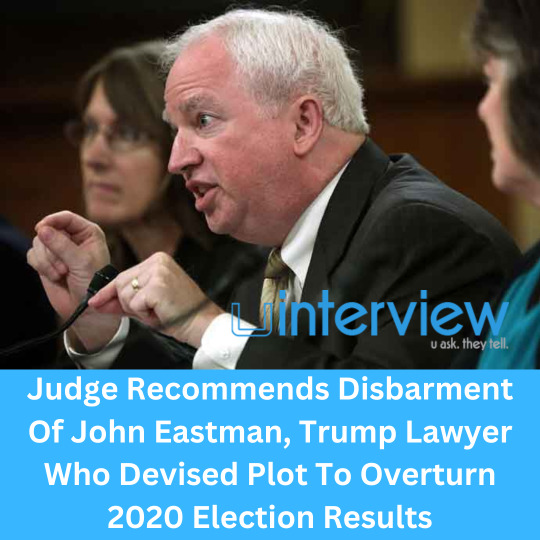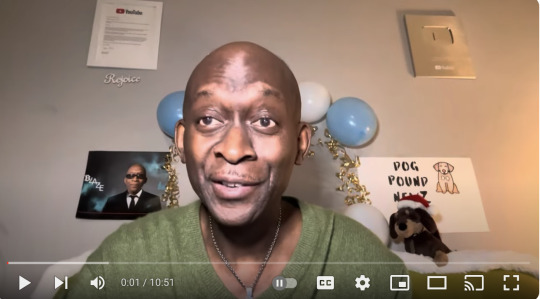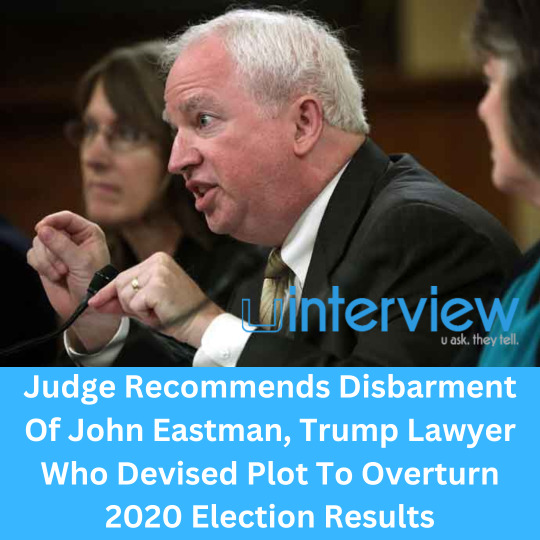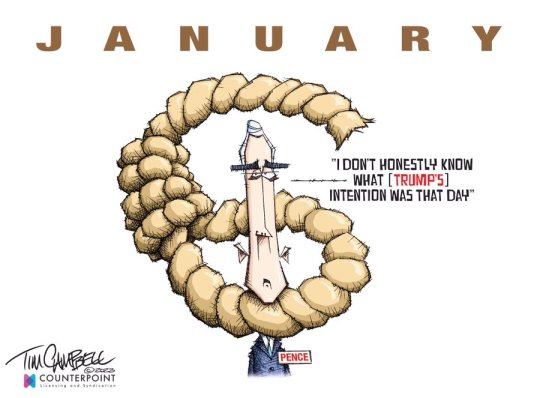#mikepence
Photo

“The American people have a right to know what took place at the Capitol on January 6th,” he said. “But make no mistake about it, what happened that day was a disgrace, and it mocks decency to portray it in any other way.” “January 6th was a tragic day for our nation,” Pence said, “It was not, as some would have us believe, a matter of tourists peacefully enjoying our Capitol. Tourists don’t injure 140 police officers by simply sightseeing. Tourists don’t break down doors to get to the speaker of the House. Tourists don’t threaten public officials.” #trump #trumptrain #TRUMP2024ToSaveAmerica #Trump2024 #mikepence https://www.instagram.com/p/CpwZcCyNC14/?igshid=NGJjMDIxMWI=
24 notes
·
View notes
Text

Full Article: https://uinterview.com/news/judge-recommends-disbarment-of-john-eastman-trump-lawyer-who-devised-plot-to-overturn-2020-election-results/
A California Bar Court Judge Yvette Roland ruled that conservative attorney John Eastman, one of the co-conspirators in former President Donald Trump‘s plan to overturn the 2020 election, should be disbarred.
0 notes
Text
Being a preacher and a Marine isn't easy.
I watch a man name Franchot Pearson on You Tube who is a decoder. https://www.youtube.com/@franchotpearson Franchot is pretty good decoder as well as Joe Acquaviva 2222. https://www.youtube.com/@josephacquaviva2222
Franchot made a video where he was struggling with what one of our ex presidents did by signing his name to an Israeli bomb. I just want to share my comment that I put on his video. I…

View On WordPress
0 notes
Video
youtube
Mike Pence to testify against Donald Trump in Georgia state RICO prosecution 👀📋👤
https://newsinfitness.com/mike-pence-to-testify-against-donald-trump-in-georgia-state-rico-prosecution/
0 notes
Text

Product: Akram https://www.blaqsbi.com/5qIv
0 notes
Text
Analysis of: Government's Reply in Support of Protective Order in Trump Jan. 6 Case (1:23-cr-00257-TSC)
PDF-Download: https://storage.courtlistener.com/recap/gov.uscourts.dcd.258149/gov.uscourts.dcd.258149.15.0_1.pdf
The document is a motion filed by the prosecution requesting a protective order in the criminal case against Donald Trump.
The defense's proposed order would allow publicity of discovery materials to try the case in the media, contrary to the purpose of discovery.
The defense attorney discussed the case publicly on TV, claiming the government seeks to limit press freedom.
The prosecution argues discovery is to ensure a fair trial, not a media campaign. Pretrial publicity could prejudice the jury.
A protective order balancing interests is appropriate, while there is no right to publicly release discovery.
The prosecution cites precedents supporting restrictions on pretrial publicity.
Evaluating the situation, the defense's media strategy risks prejudicing proceedings and degrading integrity.
The court aims to balance defendant rights with fairness and minimizing prejudicial publicity.
Stakeholders include the defense, prosecution, court, potential jurors, witnesses, media, and public.
Given the duty to ensure fairness, the court will likely find some form of protective order is warranted, and the prosecution's proposed standard order appropriately balances interests.
The executive and judicial branches are properly fulfilling their role to pursue justice, while the legislative branch does not appear directly involved in this situation.
Here is a summary of the document in bullet points:
The government filed a motion for a protective order to manage the flow of discovery to the defense in the criminal case against Donald Trump.
The defense proposed a protective order that would allow them to publicize discovery material to try the case in the media rather than in court.
On Sunday, the defense attorney appeared on TV and discussed the case publicly, claiming the government's proposed protective order was an attack on press freedom.
The defense attorney stated that former Vice President Mike Pence would be one of their "best witnesses."
The defense's proposed order would allow them to publicly disseminate discovery material, which is contrary to the purpose of criminal discovery.
The government's proposed protective order is standard and consistent with others used in the district.
The government argues that there is no right for the defense to publicly release discovery material. Discovery is meant to ensure a fair trial, not a media campaign.
The government contends that the defense attorney's goal of publicizing discovery material could prejudice the jury and degrade the integrity of the proceedings.
The government's proposed order includes restrictions that the defense seeks to remove, such as restrictions on sharing sensitive witness interview transcripts.
The government argues its proposed order would streamline discovery while preserving the integrity of the proceedings, as opposed to the defense's goal of trying the case in the media.
The document appears to be a legal motion filed by the prosecution in a criminal case.
Common evaluation criteria for such a document would include:
Legal Arguments: The strength, clarity, and cohesiveness of the legal arguments and cited precedents. The prosecution makes a strong case that releasing discovery material could prejudice the jury and degrade the proceedings. They cite relevant legal precedents to support a strict protective order.
Logic and Reasoning: The logical flow and consistency of the arguments. The prosecution presents a coherent argument that centers around the purpose of the discovery process being to ensure a fair trial, not a media campaign. They build their case logically from that foundational premise.
Thoroughness: The degree to which all relevant facts, counterarguments, and objections are addressed. The prosecution appears to be thorough in addressing the specific edits proposed by the defense to the protective order. They provide concrete examples of why those edits would be problematic.
Tone: The appropriateness of the tone for a legal motion. The tone is respectful but firm, as expected for such a document. There are no ad hominem arguments or unnecessary jabs at the defense.
Overall, based on these criteria, the evaluation of the prosecution's motion and arguments would likely be positive. The legal arguments are strong and clearly presented. The logical flow and reasoning are sound. The motion is thorough in addressing the specifics of the defense's proposed edits. And the tone is appropriate for a legal filing. The arguments, if accepted by the court, would likely achieve the prosecution's goal of a strict protective order.
Based on the content of the document, I would evaluate the prosecution's arguments as follows:
Strong Points:
The primary argument that the purpose of discovery is to ensure a fair trial, not a media campaign, is a strong legal and logical argument. Discovery rules exist to facilitate a defendant's ability to prepare a defense in court, not to wage a media campaign. This foundational premise forms a strong basis for the prosecution's position.
The prosecution cites relevant legal precedents that support restrictions on pretrial publicity and the court's authority to manage discovery in a way that minimizes jury prejudice. This lends credibility and legal authority to their arguments.
The document provides concrete examples of specific edits proposed by the defense that would improperly allow the dissemination of sensitive witness interview transcripts and other material. This helps make the prosecution's position more tangible and persuasive.
The proposed protective order is described as standard and consistent with others used in the district. This suggests it is a reasonable order that balances the interests of justice with the defendant's rights.
Potential Weaknesses:
While the document provides examples of defense counsel's comments in the media, it does not directly address whether the defendant himself made any improper public comments. Focusing more on the defendant's own statements could strengthen the arguments.
The document could provide more details about the exact nature of the criminal charges and alleged criminal conduct to help contextualize the threat of prejudice from pretrial publicity. Additional context could reinforce the need for a strict protective order.
The arguments against the defense's proposed edits to specific paragraphs of the order could be more thoroughly fleshed out in some cases. More fulsome explanations for each edit could bolster the prosecution's position.
In summary, the prosecution's central arguments regarding the purpose of discovery and the risk of jury prejudice from pretrial publicity are persuasive. The cited legal precedents and specific examples also aid their position. However, providing more context on the charged conduct and criminal case, as well as more detailed explanations for some aspects of their proposed order, could serve to further strengthen the arguments.
Based on the details in the document, the situation can be evaluated as follows:
Defense counsel's comments in the media indicate an improper intent to try the case outside of the courtroom. His stated goal of publicizing discovery material, if permitted, could seriously jeopardize the integrity and fairness of the legal proceedings. The interests of justice are best served when a case is tried based on admissible evidence in court, not in the court of public opinion.
The defense attorney's specific claims about witness testimony and the defendant's actions indicate a willingness to make prejudicial and potentially misleading statements to the media before all relevant facts are known. This could unduly influence public perceptions and taint the jury pool.
The defendant's own social media posts, as cited in a footnote, exhibit a pattern of targeting individuals and making inflammatory comments. This behavior, in conjunction with defense counsel's media strategy, suggests a real risk of prejudicing potential jurors and witnesses if discovery material is publicly disseminated.
While the defense has a right to a fair trial and access to necessary discovery, there is no absolute right to publicly release and discuss discovery materials. The court has broad authority to manage discovery and limit prejudicial pretrial publicity in service of ensuring a just outcome.
The edits proposed by the defense to the protective order appear designed to allow maximum publicity of discovery, not to ensure the defendant receives a fair trial based on admissible evidence presented in court. The defense's media strategy seems to indicate a preference for trying the case in the court of public opinion rather than the actual court of law.
In summary, based on the information presented, the situation indicates that without a strict protective order limiting the defense's ability to publicize discovery material, there is a genuine risk of prejudicing the proceedings, intimidating witnesses, and degrading the integrity and fairness of the judicial process. The defense's proposed edits to the order seem aimed at facilitating a media campaign rather than a just legal outcome. Therefore, a protective order along the lines proposed by the prosecution is likely warranted to balance the interests of all parties and serve the higher purpose of justice.
Based on the details in the document, the roles of the involved government branches could be evaluated as follows:
Executive Branch (Prosecution/Justice Department):
The prosecution has proposed a standard protective order seeking to manage the flow of discovery in a way that preserves the integrity of the judicial process. Their role is to pursue justice fairly and ensure the defendant receives all discovery to which he is legally entitled, while also protecting the interests of witnesses, potential jurors, and the public.
The prosecution argues that publicly releasing discovery material could prejudice witnesses, potential jurors, and the fairness of the proceedings. They cite legal precedents supporting their position that pretrial publicity should be limited.
Overall, the prosecution appears to be acting properly within the scope of their duties to pursue justice fairly and professionally, while also seeking to safeguard the judicial system from potential harms caused by unfettered pretrial publicity.
Judicial Branch (the Court):
The court will decide whether to grant the prosecution's requested protective order, the defense's proposed order, or some modified version.
The court has a constitutional duty to minimize the effects of prejudicial pretrial publicity and ensure the defendant receives a fair trial. The court also has broad authority to manage discovery and limit extrajudicial statements by attorneys to serve the interests of justice.
Ultimately, it will be up to the court's discretion and judgment to balance the competing concerns of the prosecution, defense, media, and public to determine what protective order, if any, is warranted to best serve the higher purpose of a just outcome.
Legislative Branch:
The document does not indicate a significant role for Congress in this particular situation. Discovery rules and the court's authority to manage publicity are established by acts of Congress and local rules, but there does not appear to be any need for new legislation to address this situation.
In summary, while the prosecution seeks to limit pretrial publicity in service of justice, the judicial branch bears the ultimate responsibility for determining what limits or controls, through a protective order or other means, are necessary and appropriate to strike the proper balance between the defendant's rights, the public interest, and the higher goal of a fair trial and just outcome. The court must use its authority wisely to ensure the proper functioning of the judicial system in this case.
Based on the details in the document, the key stakeholders affected by the situation and proposed protective order would likely include:
Donald Trump/The Defense:
Evaluation: The defense wants maximum publicity of discovery material to try the case in the media. Their proposed protective order edits are aimed at facilitating a media campaign rather than ensuring a fair trial based on admissible evidence. While the defense has a right to necessary discovery and a fair trial, there is no absolute right to publicly release discovery material.
The Prosecution:
Evaluation: The prosecution seeks a protective order to manage discovery in a way that preserves the integrity of the judicial process. They argue that publicly releasing discovery could prejudice the proceedings, witnesses, and potential jurors. The protective order they propose appears standard and reasonable. They appear to be properly fulfilling their role to seek justice fairly and professionally.
The Court:
Evaluation: The court must weigh the competing concerns of all stakeholders to determine what protective order, if any, is necessary and appropriate to balance the defendant's rights, preserve the integrity of the judicial system, and achieve a just outcome. The court has broad authority and responsibility to minimize the effects of prejudicial pretrial publicity.
Potential Jurors:
Evaluation: If discovery material is publicly disseminated, potential jurors could be exposed to inadmissible or misleading information that could bias them and undermine the defendant's right to an impartial jury. A protective order limiting pretrial publicity would help safeguard the impartiality of any future jury pool.
Witnesses:
Evaluation: Public release of discovery material could expose witnesses to intimidation and undue influence. A protective order could help protect the privacy and safety of witnesses.
The Media:
Evaluation: The media has a right to cover the criminal proceedings and report on matters of public interest. However, the defense's arguments that a protective order would impinge press freedom appear overstated. The court has authority to manage discovery in a way that balances the public interest with the interests of justice.
The Public:
Evaluation: The public has an interest in transparency regarding criminal proceedings involving a former president. However, unfettered pretrial publicity could also undermine the integrity of the judicial system and the defendant's right to a fair trial. A properly tailored protective order could balance these competing public interests.
In summary, while many stakeholders could be affected in various ways, the prosecution, defense, court, and public all ultimately share a common interest in a just outcome achieved through a fair trial based on applicable law and admissible evidence - not a media campaign. A protective order, if properly crafted, could help balance the needs of all involved to best serve the interests of justice.
Based on the details in the document, the court's likely judgment regarding a protective order in this case would likely include the following considerations:
The court's primary duty is to ensure a fair trial and uphold the integrity of the judicial system. This includes minimizing the effects of prejudicial pretrial publicity.
The court has broad authority and discretion to manage discovery and place reasonable restrictions on attorneys to limit extrajudicial statements that could bias potential jurors, intimidate witnesses, or otherwise jeopardize a fair trial based on admissible evidence.
The court is likely to find that the defense's stated goal of publicly releasing discovery material to try the case in the media, rather than in the courtroom, is improper and could seriously threaten the fairness and integrity of the proceedings if permitted.
The court is likely to agree with the prosecution that there is no right for the defense to publicly release discovery material obtained solely for the purpose of preparing a legal defense. Discovery is meant to facilitate a fair trial, not a media campaign.
While carefully balancing the competing interests of transparency, the defendant's rights, and the needs of justice, the court is likely to find that a protective order of some form is warranted to manage discovery in a way that limits prejudicial pretrial publicity.
The court is likely to find that the prosecution's proposed protective order, which is described as standard and consistent with others used in the district, provides a reasonable framework that balances the various competing concerns in a way that best serves the interests of justice.
The court is unlikely to grant the defense's proposed edits to the protective order, which appear designed primarily to facilitate maximum publicity of discovery material rather than ensure a fair trial based on admissible evidence.
In summary, given the court's constitutionally mandated duty to minimize prejudicial pretrial publicity and ensure a fair trial, the court is likely to agree with the prosecution that a protective order of some kind is warranted in this case. The prosecution's proposed protective order, which is described as standard and consistent with others used in similar cases, appears to best achieve the proper balance between competing interests in a way that serves the higher purpose of justice.
Of course, this analysis is based solely on the limited details presented in the document. The court's ultimate judgment will depend on a thorough review of the complete facts and legal arguments presented by both sides. The above represents my best attempt at predicting the court's likely ruling based solely on the information provided.
j86bYW4IVR3zLZIyZ59U
#DonaldTrump#MikePence#TrumpCriminalTrial#POTUS#DOJ#WhiteHouse#SCOTUS#Courts#Judiciary#RuleOfLaw#ImpartialTrials#JuryPool#PreTrialPublicity#DiscoveryProcess#ProtectiveOrders#AttorneyEthics#FirstAmendment#FreePress#GovernmentTransparency#Politics#Elections#JusticeSystem#Prosecution#DefenseLawyers#LegalProceedings#FairTrials#CriminalCharges#Bias#Influence#WitnessIntimidation
0 notes
Text
#schoolofvisualarts#pratt#nyu#nyupsych#fairfieldct#fairfieldconnecticut#easthavenct#coronavirus#2019#donaldtrump#mikepence#chelsea
1 note
·
View note
Text

Full Article: https://uinterview.com/news/judge-recommends-disbarment-of-john-eastman-trump-lawyer-who-devised-plot-to-overturn-2020-election-results/
A California Bar Court Judge Yvette Roland ruled that conservative attorney John Eastman, one of the co-conspirators in former President Donald Trump‘s plan to overturn the 2020 election, should be disbarred.
0 notes
Text
Donald trump
Make America great again
I remember when Donald trump became president and I did not agree with some of his policies but he was hilarious. He stood his ground and he had swag.
When covid happened, I would watch Fauci and Mike Pence and everyone at the white house. They all had these smirks on their face, like ‘yeah look at us… were killing so many people yet they all need us.’
They would put Donald Trump forward, and…
View On WordPress
0 notes
Text
Life Is Hectic / We Felt The Pressure (Part Seven)
Hopefully for some healing is taking place on this Sunday morning, a dude keeps telling y’all that life is hectic!
We felt the pressure, naysayers were laughing shouting “ain’t that a shame” ; sorry! asking us, don’t we feel it, “it’s electric”…
…”boogie woogie woogie” like its some kind of linedance per Marcia Griffiths and the Electric Boogie; but while we’re out here trying to advance per…
View On WordPress
#aintthatashame#djmixes#ElectricSlide#FoxMulder#JackSmith#LifeIsHectic#MarciaGriffiths#MikePence#poetry#RobertMueller#sundayjazz#SundayMorning#TrumpIndictment#WeFeltThePressure
0 notes
Link
#Pence corrects #Trump supporter
0 notes

